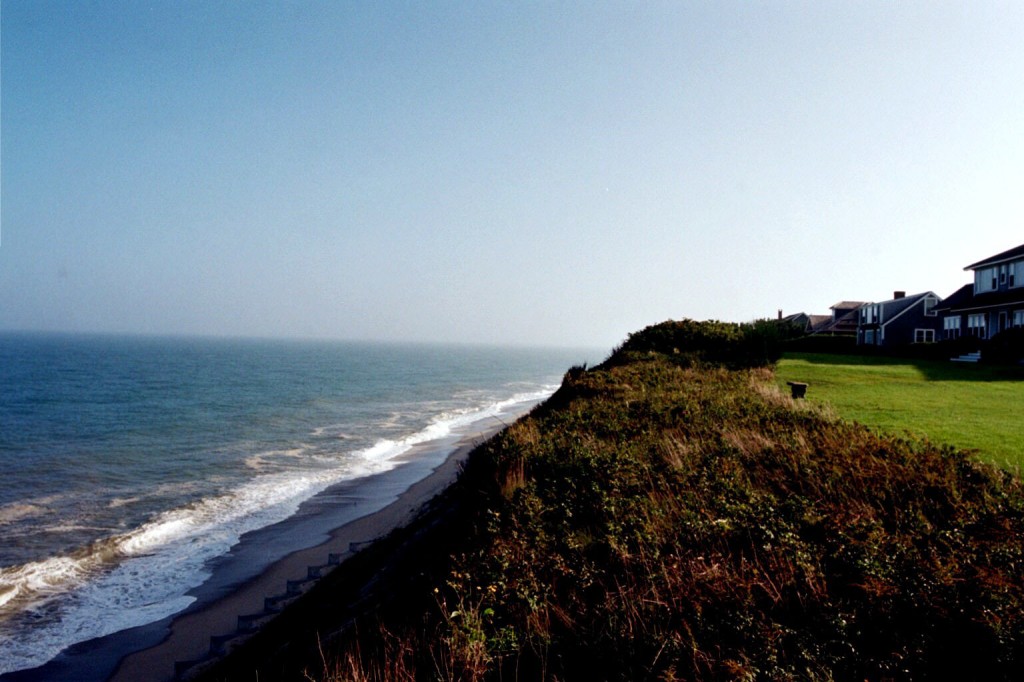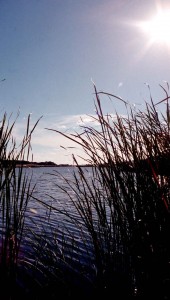Autumn Ambling on Nantucket
NANTUCKET ISLAND, Mass. – Forget visiting in July or August when the crunch of tourists crowding these historic streets resembles the running of the bulls at Pamplona.
Nantucket is at its best in the off-season — the golden light of autumn, the frosty rime of winter and the fresh green of spring. But in any season save the cobbled streets and stately homes of Nantucket Town for a rainy day.
Reserve fine days for the remoter reaches of Nantucket, which offer a tantalizing variety of hikes, rambles and walks on deserted beaches, scenic headlands and rolling moors.
Riptide and lighthouse at Great Point
 The most ambitious and rewarding hike on the island is the strenuous 12-mile round trip to Great Point, where the roisterous swells of the Atlantic Ocean collide with the calmer waters of Nantucket Sound to form a rip tide favored by surf fishermen.
The most ambitious and rewarding hike on the island is the strenuous 12-mile round trip to Great Point, where the roisterous swells of the Atlantic Ocean collide with the calmer waters of Nantucket Sound to form a rip tide favored by surf fishermen.
The hike begins at the gate house on Wauwinet Road, following the private road through the compound of the pricey Wauwinet Inn and past a dozen enormous summer homes sprawled across the dunes between the ocean and the head of the harbor.
This narrow band of dunes was dubbed the haulover by fishermen in the early 1800s who dug a trail through the dunes so they could drag their boats across the sand to reach the ocean fishing grounds south of the island without sailing around Great Point. To the east roll the breakers of the Atlantic surf, and seven miles to the southwest across the sun-dazzled waters of the Nantucket Harbor, the spires of the town poke through the canopy of trees.
About three miles into the hike, the dunes widen at Coskata Woods, a 60-acre remnant of the ancient maritime oak forest that once covered most of the island. Nantucketers passed a law forbidding cutting these woods in 1711, perhaps because sailors are a suspicious lot and early mariners claimed to have seen a mermaid flee into the trees when men approached.
The dunes narrow again at the mile-long thread of sand known as the Galls. Heading out, take the Atlantic side if you don’t mind a salty breeze in your face and the thunder of the sea in your ears. Keep one eye on the surf for the gray and harbor seals which frequent this remote beach and the other on the dunes where the lighthouse will soon rise into view.
Nestled in the dunes where the sea meets the sound, Great Point Light is a reconstruction of the 1818 lighthouse which fell to an Atlantic storm in March 1984. The $1 million replica completed in 1986 stands amid a 24-acre national wildlife refuge that is home to threatened piping plovers and least terns.
Expect to share the sand at the tip of Great Point with surfcasters angling for striped bass and false albacore. The land narrows down to nothing except for an endless and exhilarating vista of sky and sea.
 The back yards of ‘Sconset
The back yards of ‘Sconset
Two of the most charming walks on Nantucket can be found at the east end of the island in the village of Siasconset, known as ‘Sconset. Fishing shanties dating from the 17th and 18th century form the rose-covered heart of what is surely one of the most scenic villages in America. Towering shade trees, miniature cottages, picket fences, secret gardens, shell-strewn paths—every turn of the corner reveals another quaint treasure. In a world awash with the manufactured charm of theme parks and retro redevelopment, ‘Sconset offers a rare bit of authenticity.
Perhaps the most surprising throwback to a simpler time is the public footpath that cuts through the backyards of some of the most expensive Atlantic-view homes in America. The mile-long path atop the 100-foot bluff begins at the north end of Front Street in the oldest part of ‘Sconset.
In some places, such as the compound of the Wade Cottages, the public path is little more than a scuff in the grass. In others, wealthy homeowners have sacrificed their ocean view to wall off the teeming masses behind a hedge of thick shrubbery.
The cottages themselves are lavish in size but uniform in their prim traditional Nantucket exteriors—sided in silvered cedar shingles, trimmed mostly in white – and their tasteful settings amid lush lawns and well-tended flowers. After the first few, the inland view becomes somewhat monotonous.
But here a gardener has trimmed the boxwood into the shape of a whale. There a row of forest-green Adirondack chairs facing the sea ends with three sized for children, the last one in flaming red. And the appearance in one side yard of a much-used swing set comes as something of a shock.
But the real show is the sea crashing into the sand below in huge rollers that come all the away from Portugal. Even when the Atlantic is calm, three-foot curlers thunder as they break upon the beach. Two reminders of that restless power tower above this historic village – Sankaty Head light and a Coast Guard radio tower. There is history here, too. In April 1912, the Marconi marine radio operator at Siasconset station received 44 messages sent by Titanic survivors to their relatives as they steamed toward New York aboard a rescue ship.
October light at Hummock Pond
 The best inland hike on Nantucket explores the swamps, moors and woods near Hummock Pond with an emphasis on wildflowers and wildlife. The island is liberally sprinkled with freshwater ponds and, at 2.5 miles from its head on the heath to the surf at Cisco Beach, Hummock Pond is the longest.
The best inland hike on Nantucket explores the swamps, moors and woods near Hummock Pond with an emphasis on wildflowers and wildlife. The island is liberally sprinkled with freshwater ponds and, at 2.5 miles from its head on the heath to the surf at Cisco Beach, Hummock Pond is the longest.
The six-mile round trip hike to the sea begins on the Madaket Road, and 26 interpretive markers describe the history of the property and the moorland ecosystem. On a fine autumn afternoon, the rolling heath is a refreshing change from the island’s shore—so quiet you can hear the buzz of insects and so still you can feel the warmth of the sun. Clumps of wildflowers dot the moorlands and pop out beneath the shrubbery. The asters have faded, but the goldenrod blazes and the rosa rugosas remain summer fresh. Bushes of blueberries and huckleberries still boast ripening fruit.
By October Hummock Pond’s osprey have left the island for their wintering ground. Look instead for red-tailed hawks hunting voles and don’t be surprised to flush s ring-necked pheasant from hiding.
The best vista comes after a mile-and-a-half at a the barn at Ram Pasture. To the south the sun breaks into diamonds on the surf at Cisco Beach. To the east a scatter of buildings marks the hamlet of Madaket. And to the west Hummock Pond glitters in the October light.
Other inviting treks
 Nantucket offers many other inviting treks. Ambitious hikers can aim for Smith’s Point on the western end of the island, reachable from Massachusetts Avenue in Madaket. Altar Rock in the middle moors offers an unsurpassed view from atop a 103-foot hill that’s reachable from the Milestone or the Polpis road. An easy ramble to a fine view of Nantucket Sound is available at Tuppancy Links on the Cliff Road, a former golf course turned nature preserve. Many of Nantucket’s famous pleasures are obvious to any day tripper. But experienced visitors know that some of the island’s greatest treasures lie far from historic Nantucket Town.
Nantucket offers many other inviting treks. Ambitious hikers can aim for Smith’s Point on the western end of the island, reachable from Massachusetts Avenue in Madaket. Altar Rock in the middle moors offers an unsurpassed view from atop a 103-foot hill that’s reachable from the Milestone or the Polpis road. An easy ramble to a fine view of Nantucket Sound is available at Tuppancy Links on the Cliff Road, a former golf course turned nature preserve. Many of Nantucket’s famous pleasures are obvious to any day tripper. But experienced visitors know that some of the island’s greatest treasures lie far from historic Nantucket Town.
This story originally appeared in the Atlanta Journal-Constitution on October 19, 2003.
Copyright 2003 © by Beth Quinn Barnard of text and photographs. All rights reserved. Reproduction in whole or in part without permission is prohibited.

No Responses to “Autumn Ambling on Nantucket”